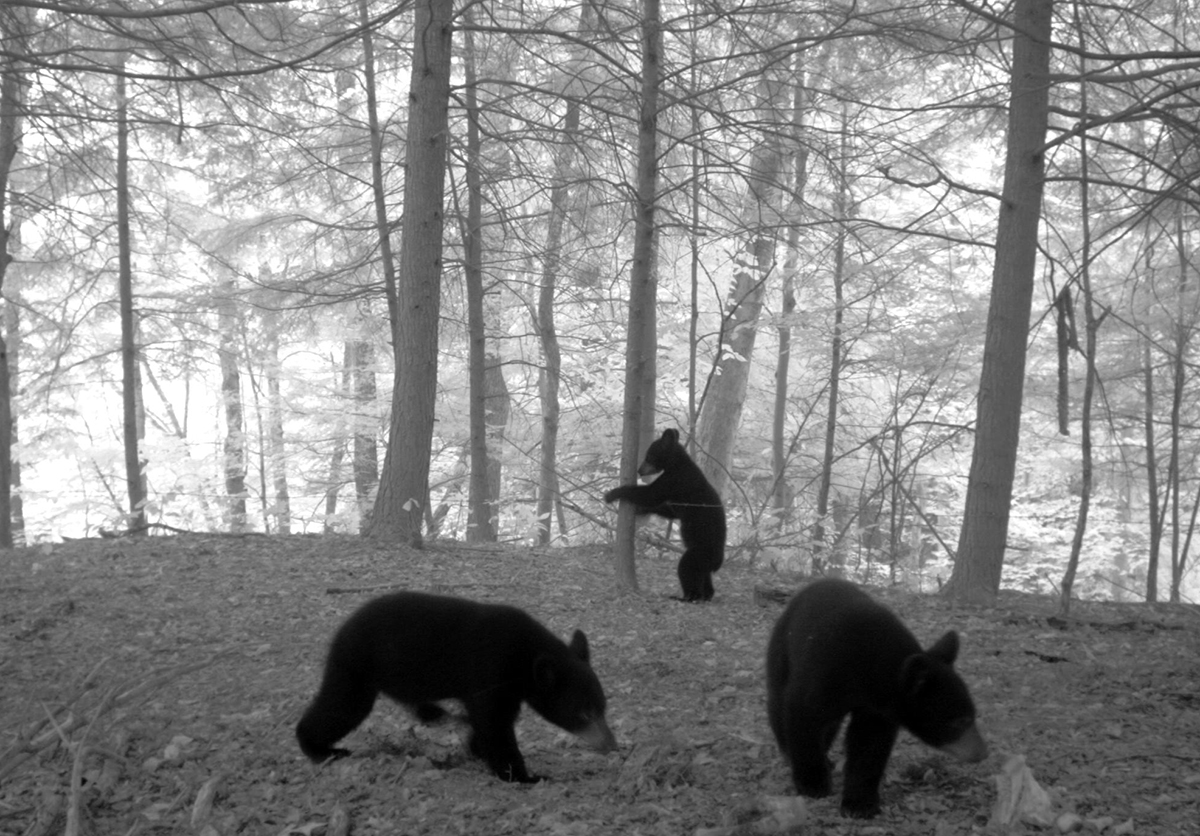April 26, 2017
Black bears on the move in upstate New York

Photograph from a trail camera of three sibling cubs investigating bait-and-scent lures at a research site near Almond, New York. Attractants were necessary to increase the probability of detecting bears that were in the area. Cameras provide a way to collect data on the presence and absence of wildlife.
The black bear population in southern New York has grown and expanded their range since the early 1990s, which has led to increased encounters with humans. But details about bear populations in the state have remained understudied.
New Cornell research, published in the March issue of the Journal of Wildlife Management, estimates the densities of black bears in southern New York and examines how bears are distributed relative to the amount of forest, agricultural lands and human development across the study area.
NY State Female Black Bear with cub
NY State Female Black Bear with cub
The researchers estimate that the average density of black bears in the southern New York area was about 13 bears per 38.6 square miles or about one bear for every 3 square miles. Bear densities decreased slightly farther north in the study region, supporting the idea that black bear ranges have been expanding northward.
Furthermore, the study found no relationship between bear densities and the amount of forest or agricultural land that existed in the region.
The findings will help inform New York State Department of Environmental Conservation (NYS DEC) wildlife managers as they look for ways to effectively manage bears now and in the future.
“Black bears are encountering human populations more now than they ever have before,” said Catherine Sun, a doctoral student in the Department of Natural Resources and the paper’s lead author. “Our study shows how bears are distributed on the landscape at the edge of their range and provides clues for how bears might continue to use landscapes farther north Said Angela Fuller, an associate professor of natural resources, leader of the New York Cooperative Fish and Wildlife Research Unit and a co-author of the paper, “There might be limited constraints to bears continuing to move northward because they are using a diversity of land cover types.”
NY State Black Bear in woodlands
Black Bear distribution in New York.
Primary range refers to areas where breeding bears were known to occur.
Secondary range includes areas with routine bear sightings.
Transient and dispersing bears may be found in all of upstate New York,
including areas generally considered unoccupied by bears
NY State Black Bear in woodlands
Black Bear distribution in New York.
Primary range refers to areas where breeding bears were known to occur.
Secondary range includes areas with routine bear sightings.
Transient and dispersing bears may be found in all of upstate New York,
including areas generally considered unoccupied by bears
New York has three historic bear ranges: the Adirondack, Catskill and Allegheny mountain regions. But the Catskill and Allegheny ranges have expanded and now are jointly considered a single range that covers the entire Southern Tier region of New York. The researchers focused on a 40-mile-by-40-mile square in this region, choosing this area because it included both historic and expanded ranges. “That’s where a lot of the population growth has been so that’s where we wanted to put our research efforts,” Sun said.
Black Bear scratching on tree
Black Bear scratching on tree
The researchers set up close to 200 research sites, with lines of barbed wire used to snag hair samples from passing bears over two summers. They extracted DNA from the hair samples, and using genetics, identified which bear left each particular sample. Sun collected some 2,000 hair samples from 257 bears.
“We are using a noninvasive genetic approach, an important new method that wasn’t available 15-20 years ago,” said Fuller. “In the past, we had to go out and capture and then physically tag each bear.” “We can collect a lot more data from many more bears than we could have with more traditional methods,” Sun said.
They applied their data to a model to estimate population densities and land-use patterns and to test ecological hypotheses. The noninvasive approach has now been applied to studying populations of other species, the researchers said. For example, Fuller leads a research project on moose in the Adirondacks that utilizes the noninvasive genetic approach – instead of collecting hair, they use dogs that are trained to smell moose pellets, from which they then extract the DNA and identify the individual moose that left the scat pile.
The study serves as a pilot for future studies to better understand black bear densities and distributions within larger regions across the state, Fuller said.
“It’s likely there is going to be further expansion of bear populations northward, which reaches into areas that have higher human populations,” Fuller added. A citizen science project called iSeeMammals is underway to collect data on bears across upstate New York, in which hikers, hunters and other naturalists contribute information on the presence and absence of bears and bear signs.
“It’s likely there is going to be further expansion of bear populations northward, which reaches into areas that have higher human populations,” Fuller added. A citizen science project called iSeeMammals is underway to collect data on bears across upstate New York, in which hikers, hunters and other naturalists contribute information on the presence and absence of bears and bear signs.
Matthew Hare, associate professor of natural resources, and Jeremy Hurst, a wildlife biologist at the NYS DEC, are co-authors of the study, which was funded by the NYS DEC and the Doris Duke Charitable Foundation.


















No comments:
Post a Comment